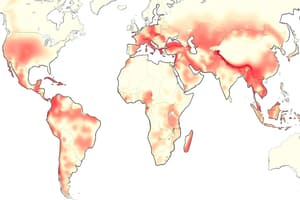Podcast
Questions and Answers
What factor is NOT mentioned as influencing cancer incidence?
What factor is NOT mentioned as influencing cancer incidence?
- Gender
- Occupation (correct)
- Age
- Geography
Which cancer is most common in younger individuals of both genders?
Which cancer is most common in younger individuals of both genders?
- Leukemia (correct)
- Breast cancer
- Lung cancer
- Prostate cancer
Which of the following cancers is more common in older age for females?
Which of the following cancers is more common in older age for females?
- Leukemia
- Skin cancer
- Colorectal cancer (correct)
- Sarcoma
At what age group does breast cancer incidence start to decline, according to the provided information?
At what age group does breast cancer incidence start to decline, according to the provided information?
What is a consequence of accumulating somatic mutations in relation to cancer?
What is a consequence of accumulating somatic mutations in relation to cancer?
Which environmental agent is specifically associated with lung carcinoma?
Which environmental agent is specifically associated with lung carcinoma?
What is a characteristic of leukemias in older age compared to younger age?
What is a characteristic of leukemias in older age compared to younger age?
What reduces the prevalence of Kaposi sarcoma?
What reduces the prevalence of Kaposi sarcoma?
Which of the following agents is associated with angiosarcoma of the liver?
Which of the following agents is associated with angiosarcoma of the liver?
What dietary factors increase the risk of malignancy?
What dietary factors increase the risk of malignancy?
Which genetic syndrome is linked to a predisposition for breast and ovarian cancer?
Which genetic syndrome is linked to a predisposition for breast and ovarian cancer?
What is a known consequence of smoking?
What is a known consequence of smoking?
Which of the following conditions is considered a non-hereditary predisposing condition to cancer?
Which of the following conditions is considered a non-hereditary predisposing condition to cancer?
Which type of cancer is not typically related to occupational exposures?
Which type of cancer is not typically related to occupational exposures?
Which of the following cancers has been linked to heavy alcohol use?
Which of the following cancers has been linked to heavy alcohol use?
Which genetic condition is associated with defective DNA repair mechanisms?
Which genetic condition is associated with defective DNA repair mechanisms?
Flashcards
Cancer Incidence
Cancer Incidence
The number of new cancers occurring in a population each year, expressed per 100,000 people at risk.
Factors Affecting Cancer Incidence
Factors Affecting Cancer Incidence
Cancer incidence varies based on age, gender, geography, and genetics.
Age and Cancer Incidence
Age and Cancer Incidence
Cancer risk increases with age due to genetic mutations and reduced immune function.
Common Cancers in Young Females
Common Cancers in Young Females
Signup and view all the flashcards
Common Cancers in Older Females
Common Cancers in Older Females
Signup and view all the flashcards
Kaposi Sarcoma
Kaposi Sarcoma
Signup and view all the flashcards
Environmental Cancer Variables
Environmental Cancer Variables
Signup and view all the flashcards
Occupational Cancer Risks
Occupational Cancer Risks
Signup and view all the flashcards
Lymphoma
Lymphoma
Signup and view all the flashcards
Vinyl Chloride
Vinyl Chloride
Signup and view all the flashcards
UV Light
UV Light
Signup and view all the flashcards
Alcohol Abuse
Alcohol Abuse
Signup and view all the flashcards
Autosomal Dominant
Autosomal Dominant
Signup and view all the flashcards
BRCA1/BRCA2 Genes
BRCA1/BRCA2 Genes
Signup and view all the flashcards
Chronic Inflammation
Chronic Inflammation
Signup and view all the flashcards
Xeroderma Pigmentosum
Xeroderma Pigmentosum
Signup and view all the flashcards
Study Notes
Epidemiology of Cancer
- Cancer incidence is the number of new cancers of a specific site/type occurring in a specified population during a year.
- It's usually expressed as the number of cancers per 100,000 population at risk.
- Cancer incidence varies based on age, gender, geography, and genetics.
- Cancer incidence is reported by gender (male and female) and age groups.
Environmental Variables
- Occupational exposures can increase cancer risk.
- Asbestos exposure is linked to lung carcinoma, mesothelioma, and gastrointestinal tract malignancies.
- Benzene is associated with leukemia.
- Vinyl chloride is a risk factor for angiosarcoma, liver, and lymphoma.
- Ethylene oxide exposure is linked to leukemia.
- Ultraviolet (UV) light exposure is a risk factor for melanoma.
- Formaldehyde/wood dust exposure is associated with nasopharyngeal cancers.
- Exposure to arsenic and inorganic arsenic compounds increase prostate cancer risk.
Other Factors Affecting Cancer Risk
- Alcohol abuse increases the risk of cancers of oropharynx, larynx, esophagus, colon, liver, and breast.
- Smoking is a significant risk factor for cancers of the lung, mouth, pharynx, larynx, esophagus, and pancreas.
- Diet plays a role in malignancy risk. Overweight, vitamin deficiencies, and diets high in animal fats can increase cancer risk.
- Reproductive factors - prolonged unopposed estrogen stimulation can increase certain cancer risks.
- Infectious agents can also contribute to cancer development.
Genetic Predisposition to Cancer
- Inheritance of cancer can be:
- Autosomal dominant: Includes retinoblastoma, Li-Fraumeni syndrome, familial adenomatous polyposis, colorectal adenocarcinoma, neurofibromatosis, breast and ovarian cancers.
- Autosomal recessive: Includes xeroderma pigmentosum, ataxia telangiectasia, Bloom's syndrome, and Fanconi's anemia.
- Familial cancers: Cancer can run in families. Some examples are breast, ovarian, and pancreatic cancers.
Non-Hereditary Factors
- Chronic inflammation: Conditions like Ulcerative colitis, Helicobacter pylori gastritis/ulcer, and viral hepatitis can lead to cancer.
- Precancerous conditions: Certain conditions can increase cancer risk, such as Barrett's esophagus, chronic atrophic gastritis, cirrhosis, chronic oral irritation, Marjolin's ulcer, and neurofibromatosis.
- Immune deficiency: Deficiencies in T-cell immunity can increase cancer risk.
Studying That Suits You
Use AI to generate personalized quizzes and flashcards to suit your learning preferences.




